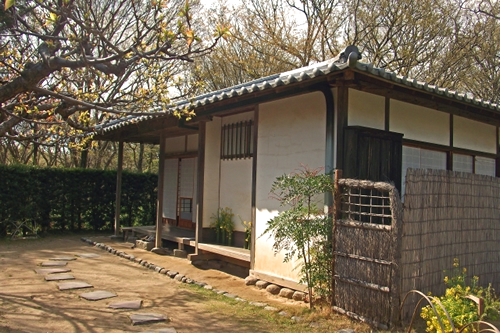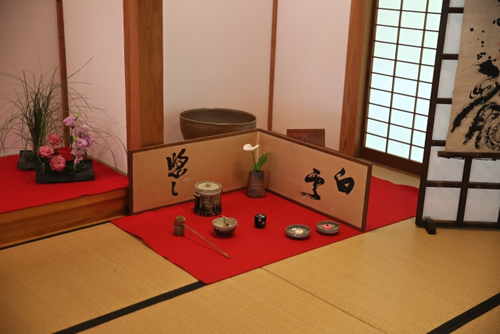Posted by TOKYO MATCHA SELECTION on 2nd May 2017
Japanese tea ceremony starts from Roji bare ground

Space of Japanese tea ceremony is special. There are mainly Roji bare ground (露地) and a tea room of Japanese tea ceremony (茶室).
Roji bare ground is also known as a tea garden. It also means mental state that gets rid of desire and restraint by Buddhism term. Roji bare ground has the function of path to a tea room of Japanese tea ceremony. It is also the place that a guest gets ready for Japanese tea ceremony mentally. The guest walks around Roji bare ground and imagine that he is going to meet a master soon.
Roji bare ground is very different from a usual Japanese garden. In old days, rulers used to have a garden to show off their strength. They made pond, river, and mountain in the garden to imitate nature. Compared to the garden, Roji bare ground does not have pond, river, or mountain and it has very simple structure. It might sound lonesome without the sound of river and pond, however, that simple space was ideal for tea masters such as Sen no Rikyu. That was an appropriate space for Japanese tea ceremony. In other words, Japanese tea ceremony has created a garden which is different from any other gardens.
A historical expert says that Japanese garden did not have garden such as Roji bare ground which has clear objective. In Roji bare ground, a person moves for one object which is Japanese tea ceremony.
Sen no Rikyu thought that Roji bare ground is not just path but the place for calming heart. The guest entering Roji bare ground stops as standing and calms one's heart. Then, the guest goes step by step on stones towards a tea room of Japanese tea ceremony. Roji bare ground is a garden which one enters the world of Japanese tea ceremony departing from daily life.
There are stones in Roji bare ground. They are called "Tobiishi". Tobiishi is a stone that guides a guest to a tea room of Japanese tea ceremony. It is placed from the entrance of Roji bare ground to the entrance of a tea room of Japanese tea ceremony. When you walk in Roji bare ground, you step on the Tobiishi but not on the ground.
There is a place called "Tsukubai" in Roji bare ground. Tsukubai consists of some stones and it is a place for washing hands. The guest can purify body and mind here.
There is also a stone called "Ishidouro". Ishidouro is used as lighting in Roji bare ground. It is practically used and one of landscape at the same time.
A sacred place for a master and guest to meet

A tea room of Japanese tea ceremony is a place that a master invites a guest and makes tea for the guest.
The origin of a tea room of Japanese tea ceremony seems to be the period of Muromachi. In a painting, serving matcha for a guest in the room is depicted. In those days, the room was "Shointsukuri" which had expensive paintings and utensils imported from China. In the late period of Muromachi, people started to gather in a small room and have tea ceremony.
A tea room of Japanese tea ceremony has two different kinds of rooms. One is called "Koma". The size of Koma is smaller than four and half tatami mats. Koma makes the world of "Wabicha". Wabicha is one of forms of Japanese tea ceremony and values simplicity. Sen no Rikyu, a tea master, completed Wabicha.
Another is called "Hiroma". The size of Hiroma is bigger than four and half tatami mats. Hiroma makes the world of "Shointsukuri" which is glorious.
Four and half tatami mats is applied to size of the room because it is suitable for a master to welcome a few guests to talk or it is a just size for a person to live simply and calmly.
Inside Koma, there are four spaces. The first space is the place that a master makes matcha. The second space is the place for a guest to sit down. The third space is the space in front of Tokonoma Alcove. The last space is for a master to enter and exit the room. Each space has one tatami mat and half tatami mat is placed in the center of the room.
Tokonoma Alcove is the most important space for a tea room of Japanese tea ceremony. A master thinks first what to put on Tokonoma Alcove because the guests see and appreciate it. Japanese scroll called "Kakejiku" is placed in Tokonoma Alcove. Zen words are written on Kakejiku. For example, some put Kakejiku with words "once in a lifetime chance" (一期一会). These words mean that each Japanese tea ceremony happens just one time only and never happens again. So, a master and a guest try to be sincere because they would never have a chance to meet again. So, Kakejiku displays the spirit of Japanese tea ceremony.
As well as Kakejiku, flowers are decorated in Tokonoma Alcove. Sen no Rikyu, a tea master, said that feel a flower as it is in nature. Even just a flower, all life is included in it. In the tea room of Japanese tea ceremony, only a flower is alive. So, it is important for a master to put his feelings in a flower when decorating.
The tea room of Japanese tea ceremony is a sacred place for a master and guest to meet and enjoy matcha.